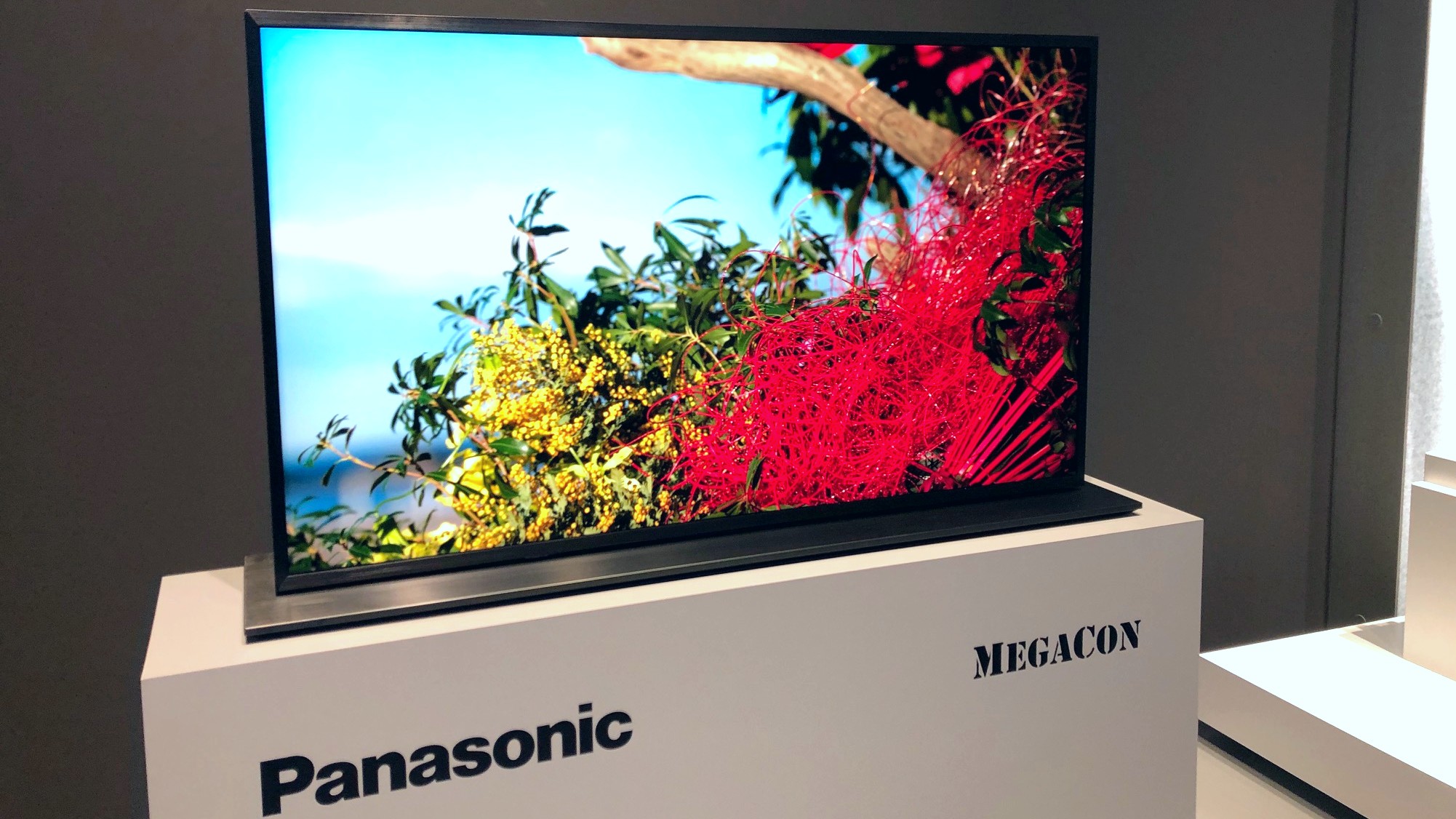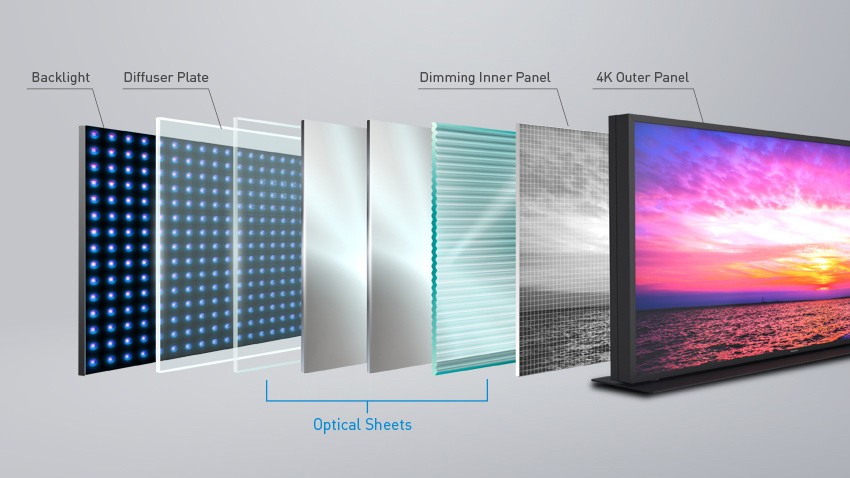First look: Panasonic MegaCon 4K Dual Panel LCD TV
This isn't your average LCD TV

Before going any further, let’s clear up right away the thinking behind the rather unfortunate name Panasonic has given to the new screen technology it’s just introduced at IFA 2019 in Berlin.
‘MegaCon’ is a reference to Mega Contrast. It is not, in any way, a suggestion that there’s anything dubious or fake about Panasonic’s revolutionary new 55-inch screen.
On the contrary, its extraordinary talents are already blisteringly apparent, despite it currently only being at the ‘advanced prototype’ stage.
- Here's the Panasonic TV lineup for 2019
Down to the nitty gritty
The best way to start understanding what the MegaCon is all about is to look at its key specifications. First, it claims a contrast ratio of 1,000,000:1 – despite being based on LCD rather than OLED technology. Second, it claims a brightness of 1000 nits – and we’re not just talking about small areas of 1000 nits, here. The whole screen can reach and hold that level of brightness.
This achievement joins with the mammoth contrast ratio in clearly marking the screen out as very much designed to handle today’s high dynamic range (HDR) content.
The MegaCon display is also reckoned to be capable of reproducing 99% of the so-called DCI P3 color spectrum that’s used in the world of digital cinema – and which is essentially the system currently used when creating most of today’s HDR content.
Unlike most LCD TVs too, the MegaCon can be watched from a wide angle with minimal loss of contrast or color saturation. Most exciting of all, the MegaCon achieves pixel level dimming.
Sign up for breaking news, reviews, opinion, top tech deals, and more.
Or, to put this in layman’s terms, even though it’s an LCD TV, its backlight system can deliver a separate amount of light to each and every pixel in the MegaCon’s 4K image. It's not the usual LED TV situation where a relatively small number of backlight zones have to share their light across large numbers of pixels, reducing contrast and causing issues with light ‘blooming’.
In fact, if you can make an LCD TV deliver light control right down to pixel level, you’re essentially replicating the self-emissive pixel situation of OLED TVs. Yet since the MegaCon is still an LCD TV, it can hit brighter HDR light peaks than OLED screens while remaining free of the permanent image retention issues that are still theoretically an OLED TV issue.

Not your average LCD
How has Panasonic managed to pull off this seemingly impossible feat? It’s all down to something Panasonic calls Dual Panel LCD technology.
If you look at the diagram of the MegaCon’s screen structure included above, the key bit to focus on is the last two stages on the right. These show a monochrome inner panel and a 4K outer panel, with the dimming panel being used to modulate the light coming from the backlighting array into individual pixels of light that are then fed into the final 4K color layer.
This approach to solving the traditional issues associated with LCD backlighting isn’t a completely new concept. Hisense, for instance, has shown off a Dual Cell ULED system which draws on the same basic concepts.
Panasonic’s take on dual panel LCD technology, though, looks and feels like nothing we’ve seen before. The screen is completely Panasonic’s own work, for instance. It uses panels manufactured by Panasonic, drawing on the knowledge of high-end ‘self emissive’ screen technologies that Panasonic has built up over decades of plasma and OLED screen experience.
It also uses a special system designed by Panasonic to perfectly align the monochrome inner and color outer layers, so that lines and pixels in the finished picture don’t suffer with ghosting or diffraction noise.

On the contrary, the MegaCon’s pictures look stunningly detailed and precise. Edges of sharply contrasting edges look pixel perfect and perfectly defined, with not even the slightest hint of any misplaced light you would expect to see with misaligned LCD layers.
The contrast between the brightest and darkest parts of the MegaCon’s pictures is unlike anything I’ve seen on an LCD TV before. Deep blacks can sit right alongside massively intense and bright peak whites and vibrant colors without any compromise. The bright picture parts don’t have to have their intensity reined in, while the inky black colors don’t have to succumb to areas of leaking light around the bright bits.
Essentially it’s like watching an OLED TV, except that bright highlights explode out of the screen with astonishing levels of punch.
You can watch the MegaCon from a viewing angle of around 60 degrees off axis without any major reduction in contrast and color too. In fact, colors look exquisitely natural and nuanced, as the screen’s remarkably wide color palette harmonizes beautifully with the screen’s pixel-level light control.
The MegaCon’s screen uses a matte finish that does a strikingly good job of absorbing reflections. This is very important for a monitor that prides itself on its handling of dark scenes, leaving you free to lap up its truly exceptional shadow detail reproduction.
Dark areas of the picture show no signs of the noise problems that can occur with many OLED TVs, either. In fact, there’s no hint of noise anywhere. Put all of these things together and you’ve got a picture performance that truly feels like it’s a generation ahead of where we are now.
Innovation comes at a cost
Before you rush out to buy one, though, you should know that Panasonic is currently only talking about the MegaCon as the next big thing in professional mastering monitors. It doesn’t have plans to launch the technology in consumer TVs. Partly, I suspect, because of the current difficulties associated with making such screens, and partly because finished products based on the MegaCon prototype will surely be eye-wateringly expensive. And then some.
As we’ve seen before, though (especially from Panasonic, actually), technology that starts out in professional mastering studios has a habit of eventually dripping down into the TVs in our living rooms.
From what I’ve seen of even this early prototype of Panasonic’s next generation TV screen, that drip down effect can’t start happening soon enough.

John has been writing about home entertainment technology for more than two decades - an especially impressive feat considering he still claims to only be 35 years old (yeah, right). In that time he’s reviewed hundreds if not thousands of TVs, projectors and speakers, and spent frankly far too long sitting by himself in a dark room.